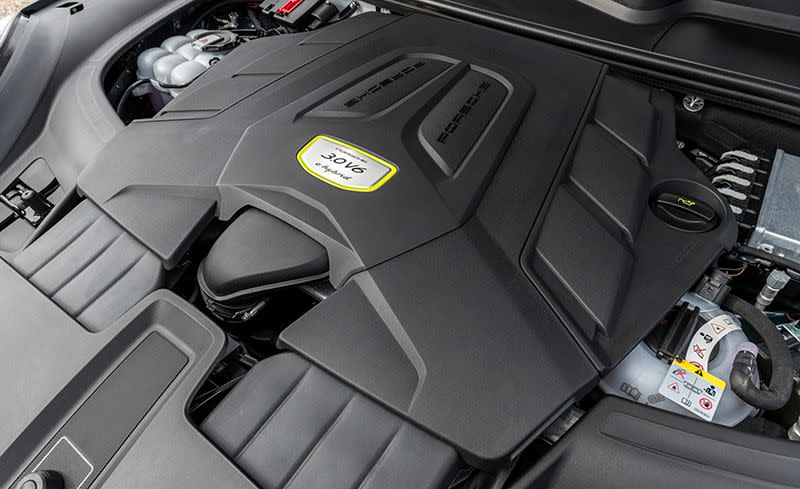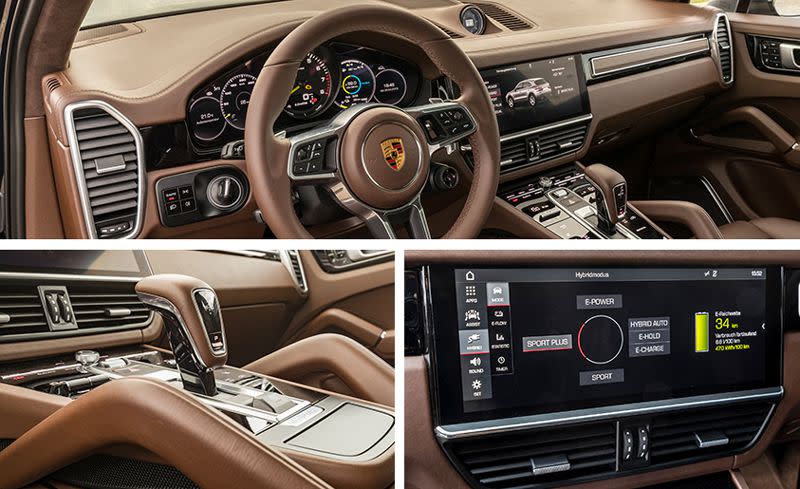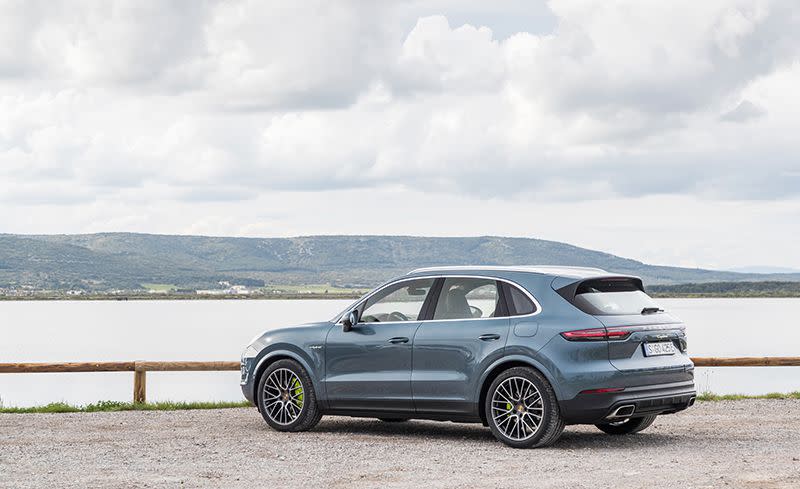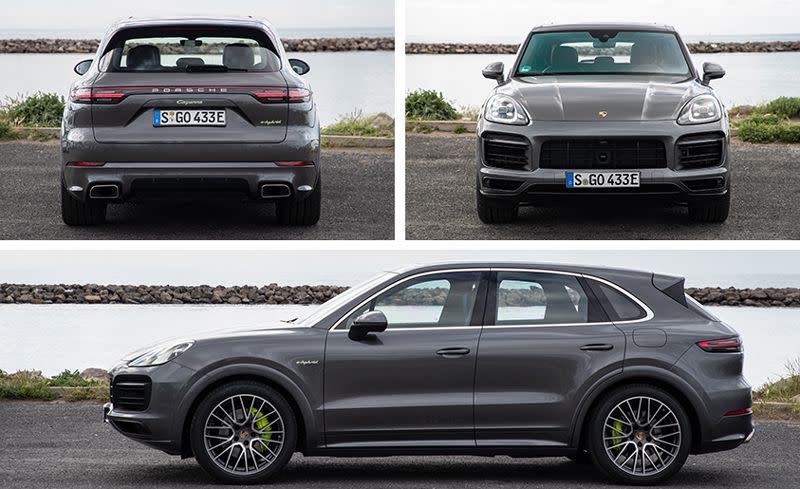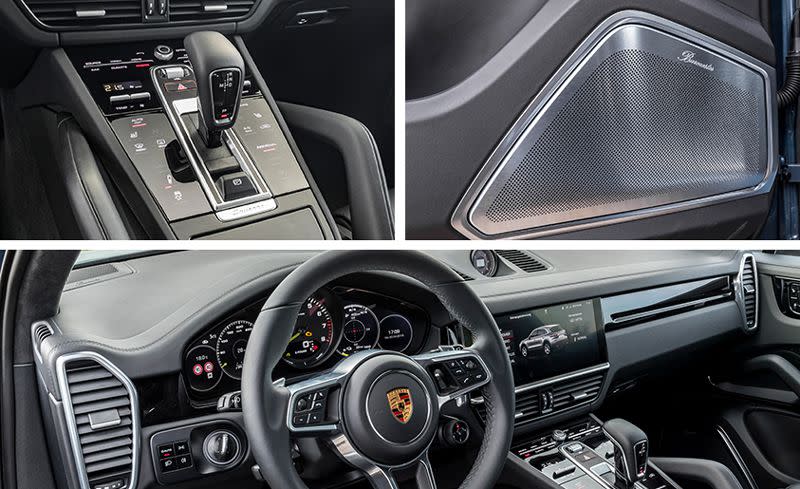We’ve Got Porsche PHEV-er: New Cayenne E-Hybrid Driven
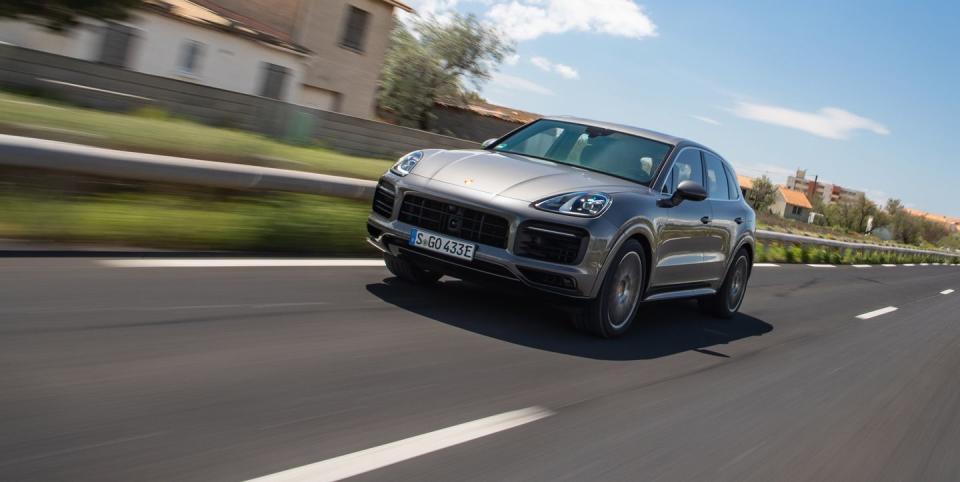
Porsche, the venerable German maker of sports cars, just rolled out the hybrid version of the third-generation Cayenne. This is the third iteration of the Cayenne SUV with a hybrid powertrain; the previous-gen Cayenne had two hybrid versions (one a regular hybrid, one a plug-in). That means there are as many generations of Cayenne hybrid as there are of the Honda Insight, which was the first hybrid of any sort offered on our shores.
The heart of the new Cayenne E-Hybrid plug-in is its powertrain, which follows a now familiar recipe: Take the root model’s engine and transmission-in this case a turbo 3.0-liter V-6 from the Cayenne tuned to 355 horsepower-then add a big battery and an electric motor. The engine carries over from the base model essentially unchanged, save for the lack of a second serpentine belt. The single ancillary drive is for the engine’s coolant pump. An A/C compressor, handling both the cabin- and battery-cooling chores, is driven by a motor fed from the high-voltage traction battery. There is no alternator or conventional 12-volt starter. Unlike many hybrids that carry a sometimes redundant and heavy starter motor, all the E-Hybrid’s engine starts are handled by the 134-hp AC motor that also contributes to propulsion. Normal 12-volt electronic systems, like engine operation and infotainment, are handled by the high-voltage battery through an inverter.
According to Friedemann Heller, powertrain product line manager for SUVs at Porsche, engineering the single motor to handle the difficult duty of a cold-engine start was a worthwhile effort for the weight savings. The only downside is that if there ever is a fault in the high-voltage battery, the Cayenne will drive like a normal car, but only for as long as the 12-volt battery’s charge endures. Wherever the SUV is shut off, assuming the fault isn’t self-correcting, is where it will sit until a tow truck arrives because there is no way to start the car without a functional high-voltage battery.
To make the electronics even more confusing to the average Joe, there also is a 48-volt subsystem on every Cayenne E-Hybrid whether or not it has the optional Porsche Dynamic Chassis Control ($3590) with its active front anti-roll bar. An active rear anti-roll bar is standard, hence the necessity for the 48-volt system on all examples. The standard rear bar counters the effect of mounting the 287-pound, 14.1-kWh high-voltage battery below the cargo floor but well above the rear differential.
Controlled Mass
The conversion to hybrid propulsion adds about 680 pounds to a base Cayenne according to Porsche, making the plug-in around 260 pounds heavier than the 550-hp V-8–powered Cayenne Turbo, but you’d be hard pressed to feel the added mass from the behind the wheel. Between the standard adaptive dampers and the optional air springs ($2170), PDCC, and rear-axle steering ($1620), the Cayenne E-Hybrid does an amazing impression of a sporty wagon by nullifying body roll without making the ride harsh. The E-Hybrid also is a nice place to spend extended periods of time as road noise is well hushed, even on the optional 21-inch wheels (19s are standard; 20s and 22s also are offered).
A dial inside the rim of the steering wheel at the 4:30 position selects from four main driving modes that vary the suspension, engine, electric motor, and transmission behavior. E-Power is the default mode and relies solely on the motor to drive the wheels. Hybrid Auto mode leaves the blending of electron- and gasoline-power up to the car’s computers, which will drive the wheels in the most efficient way. In Sport mode, the V-6 is always running, gears are held longer, and the various suspension elements get firmer. Sport Plus ratchets up the chassis even further. Two sub-modes of Hybrid Auto allow the car to charge the battery itself or hold the battery’s state of charge for later use. These are activated via the infotainment interface.
Both the engine and the motor turn at the same rpm. Swaps from electric drive, to hybrid, and back are utterly seamless. Initial tip-in from a start is damped by the torque converter and bolstered by the motor’s 295 lb-ft of torque, which is available from 100 rpm to 2400 rpm. By that point, the engine’s peak torque of 332 lb-ft is available. Working in concert, the engine and motor serve up 516 lb-ft between 1000 and 3750 rpm, but more important, 455 horses at 6400 rpm.
Sport and Sport Plus modes also ready the temporary boost mode, which when activated by pressing the button in the middle of the mode selector dial, delivers a 918-like boost to the electric half of the powertrain for maximum acceleration. Sprints to 60 mph should take about 4.4 seconds, a massive improvement of 0.8 second over what we extracted from the outgoing Cayenne S E-Hybrid.
Fuel Efficiency Meets Towing Capacity
Final EPA estimates are still pending, but we expect the new Cayenne E-Hybrid to be capable of about 20 miles of EV range with a fully charged battery, up from the previous model’s 14. The EPA combined estimate should flirt with 25 mpg, or on par with the BMW X5 xDrive40e. When fitted with the optional 7.2-kW onboard charger ($840), a fully drained battery will recharge in about 2.5 hours on a Level 2 connection (32-amp). With the standard charger (3.6 kW) that time grows to four hours.
But most wagons, let alone hybrids, can’t tow 7716 pounds. And it is for this reason that the Cayenne has its own powertrain, distinct from that used in the Panamera’s hybrid variants, complete with a torque converter and planetary automatic instead of a dual-clutch transmission. Sure, it could have been done with PDK, but the initial tip-in standards couldn’t have been met. Pulling away with a loaded trailer on a hill, for example, wouldn’t be buttery smooth. The powertrain arrangement, from tip to tail, is as follows: engine, clutch, electric motor, torque converter, eight-speed gearbox, hang-on all-wheel-drive coupler (an electronically controlled clutch), driveshaft, rear differential. This arrangement means that if the car is moving, the motor is spinning.
Lift off the gas and there is some regenerative braking, but not anywhere near one-pedal-driving levels. As the brake pedal is pressed, regen-indicator lights illuminate as more and more deceleration is asked of the system. At some point-the driver can’t be sure exactly when because it is all but undetectable and determined by myriad computer-analyzed variables-the friction brakes are employed, too.
Adding complexity to the manufacturing and ordering process, three different braking systems are offered. Iron rotors come standard, Porsche’s surface-coated brake rotors are one level up, and carbon-ceramic rotors are the top-spec option. (Final pricing for the optional brake systems is still TBD, but we expect them to be closely aligned with the standard Cayenne’s option costs, which are $3490 for surface-coated and $9080 for carbon-ceramic.) This means that the SUV needs specific blending strategies for each of the three systems. Heller says that tuning the regenerative braking system-pinpointing the moving target that is the changeover point from regen to friction-was the most difficult part of developing the car. All Porsche hybrids get their calipers painted acid green to match the green accents on the exterior badging, but customers can select white or yellow calipers if they like.
Department of the Interior
The interior choices follow the example of the multitude of optional braking and performance systems. Listing every last color, trim, and leather option would make an Antarctic expedition’s checklist seem scanty. If you want it in leather, it can be wrapped in leather. If you want paint to match Grandma’s heirloom sapphire, Porsche would probably do that, too. Most Cayennes in America, however, are sold off the lot. Only about 20 percent are made to order-roughly half the rate of 911s here. The Sport Chrono package is standard in the U.S., too, although we recommend substituting the no-cost alternative displaying an analog compass/digital altimeter/clock in its place. A stopwatch/chronograph on the dash of a plug-in Cayenne seems a bit out of place.
Like the rest of the Cayenne lineup, this model gets the newest Porsche infotainment interface. It includes a 12.3-inch high-resolution touchscreen in the center console as well as two screens flanking the analog tachometer in the instrument cluster that do admirable facsimiles of genuine dial-and-needle gauges. Apple CarPlay is standard, but Android Auto is a no-show. Porsche’s new menu structure has yet to be engrained in our subconscious, and it seems generally as though there is at least one layer too many to the various menus. And, through other experience with the same system in the Panamera, we wish the volume wheel was backlit at night. But owners will likely overcome the learning curve.
The added complexity of the portfolio and complete redesign didn’t affect the cost by so much as one dollar. The ’19 model starts at the exact same price-$80,950-as the outgoing model, despite the addition of new standard equipment including LED headlights and automated emergency braking. Adaptive cruise control along with Porsche’s crafty InnoDrive, blind-spot monitoring, and active lane-keeping assist are also available.
Choosing between the 440-hp Cayenne S and the 455-hp Cayenne E-Hybrid is purely up to preference. The E-Hybrid is $3000 cheaper than the S, and its total system output is 15 horses more than the S’s twin-turbo 2.9-liter V-6. Drawbacks for the hybrid model are so few and seemingly inconsequential that the upgrade over the S is to us a no-brainer. If Porsche’s hybrid models continue to improve this much with every generation, the company’s status as a sports-car icon might be usurped by renown for hybrid expertise. While that’s highly unlikely, Porsche, please don’t forget about all your wonderful sports cars. We’ll agree not to, either.
You Might Also Like

 Yahoo Autos
Yahoo Autos 